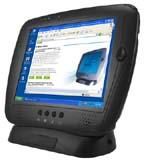WebDT 366
- Windows® Embedded and Windows XP with Windows Media Player and Internet Explorer; ICA & RDP Terminal clients; Terminal Emulation software
- Compatible with Windows CE or Windows XP applications
- Brilliant 8.4" TFT Active Matrix LCD at 800 x 600 SVGA resolution
- Integrated touch screen display with "on screen" soft keyboard support
- CompactFlash™ slot; PC Card slot; USB port
- Built-in HDD, 802.11 b/g WLAN adapter and Bluetooth available
- Full 16-bit audio with stereo; headset jack; built-in stereo speakers and microphone
Price: $350 - see this forum post for more information on ordering.
Demonstration
Google Videos:
Tech Specs
WebDT Pins (Numbered looking at front of cradle)
Power Connection is on the right-hand side of the cradle.
USB B connection is on left-hand side of the cradle, the two USB A connections are on the front.
Reading the table: The number to the left of the ":" is the pin number, the number to the right is the number on the usb connection number (as I numbered them).
1: (Unknown) 2: U13 3: U9 4: U2, U6, U11 5: U12 6: (Unknown)
7: U5, U10, U15 8: U8 9: P1 10: U7 11: U14 12: (Unknown)
13: (Unknown) 14: (Unknown) 15: (Unknown) 16: P2 17: (Unknown) 18: U1
Pins U3 and U4 connections' are unknown presently.
Installing the Orbiter
- Make sure your system is setup according to the network specifications detailed here
- Format a USB stick. I like Gparted. Use a stick that is at least 1GB.
- Download the file.
- Uncompress it
sudo bunzip2 webpad-gamma1.dd.bz2
- Copy the file to the stick using dd.
sudo dd if=webpad-gamma1.dd of=/dev/sda
where /dev/sda is the location of your USB stick. You can use Gparted to determine the location of your stick.
- Plug the stick into the WebDT 366 and power it on.
- A LinuxMCE splace screen should appear and the installation process will begin automatically.
- After the installation completes, power down the device, remove the USB stick, and power it back on.
- The device will boot and show a LinuxMCE splash screen along with a progress bar. After this is loaded, you will be presented with a screen to input your wireless settings.
- The splash screen will reappear and then a series of screens will ask for input so that an Orbiter can be generated.
Troubleshooting:
- If you receive the following error:
USB Boot Device : MASS Storage Class [00F9h/FFh/3Fh] Missing operating system. No boot device present. Halting.
you have most likely used dd incorrectly:
sudo dd if=webpad-gamma1.dd of=/dev/sda1
Note the addition of the "1" at the end of "/dev/sda". Be sure and use dd without this, or any other number.
- If your flash drive has multiple partitions, you can make a bootable USB disk with a program like UBCD and then remove the multiple partitions, create one, and then proceed with the installation instructions shown above.
- If your USB stick won't fit into the USB port of the WebDT, use a USB cable extender.
Usage
- To access the terminal, press the third soft key when the splash screen is displayed upon booting. If this does not work, attach a keyboard to the USB port and when the splash screen appears, press:
CTRL-C t
- From the terminal, you can run the configuration utility by entering:
/usr/local/bin/TabletCFG
- You can ssh into the tablet using the username of root and the password of root
- Pressing the power key once will suspend the device. Pressing it again will bring it out of suspend.
- Holding the power key will power down the device.
- Pressing the second soft key will hide the UI and pressing the first soft key will bring it back. This is useful if you don't want the UI displayed but still want quick access to using the device.
- Pressing the third soft key will bring up the wireless settings configuration screen.
- Pressing the fourth soft key will reload the orbiter.
This forum post proved most useful in creating these instructions.



